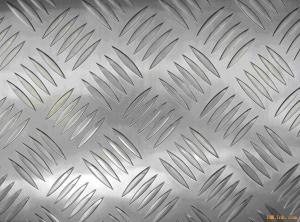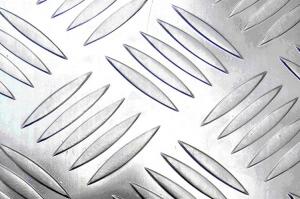Small five bar aluminium sheet
- Loading Port:
- China Main Port
- Payment Terms:
- TT OR LC
- Min Order Qty:
- -
- Supply Capability:
- -
OKorder Service Pledge
OKorder Financial Service
You Might Also Like
Product Information:
1) Alloy: 1050. 1200, 1100,, 3003, 5052, 5754
2) Temper: H111, H112, O, H14, H24, H32
3) Thickness: 0.8mm to 10mm
4) Width: 100mm to 2300mm, Length: up to 11 Meter,
5) Patterns:Two bar,three bar, Five bar and diamond plate
6) Use: Refrigeration floor, Truck floor, flooring, stairs, indoor and outdoor decoration
Business Items:
1. Payment: T/T or LC at sight
2. Delivery time: 25 Days
3. Packing: 1. Standard seaworthy export packing, wooden pallets with plastic protection for sheets;
2. For the coil, the packing is eye to sky or eye to wall based on the client requirement;
3. 16-18 MT can be loaded into 20FCL.
4. Quality: Mill Finish, Totally free from defects like White Rust, Roll Marks, Edge damage , Camber,
Dents,Holes,Break Lines, Scratch
- Q:Are aluminum sheets suitable for food preparation surfaces?
- Yes, aluminum sheets are suitable for food preparation surfaces. Aluminum is a lightweight and durable material that is commonly used in the food industry. It is non-toxic, non-reactive, and does not release any harmful chemicals when it comes into contact with food. Aluminum sheets are also easy to clean and maintain, making them a popular choice for food preparation surfaces in both commercial kitchens and home kitchens. Additionally, aluminum has excellent heat conductivity, allowing for even cooking and baking. However, it is important to note that aluminum can react with acidic or salty foods, causing a metallic taste. To prevent this, it is recommended to use a layer of parchment paper or silicone baking mat as a barrier between the aluminum sheet and the food.
- Q:HI! I have a few of my most favorite aluminum baking pans and lids that are brown with baked on grease etc...and I have not the strength or endurance to stand and buff them with a scratchy pad til they gleam....are there any cleaning chems or soaps that will do this for me?? Thanks!! Mama never told me there'd be days like this!
- Thanks, have all of the above that you mentioned...just that a few are favorites as I can pick them up easily - bad shoulders and elbows have weight bearing issues....I don't even cook all that much, but seem to burn a lot - even when boiling eggs....it is a miserable commentary on a day in the life of Aunt Susie....
- Q:What are the different methods of surface finishing for aluminum sheet?
- There are several different methods of surface finishing for aluminum sheets, each with its own unique characteristics and advantages. Some of the most common methods include anodizing, painting, powder coating, polishing, and brushing. Anodizing is a widely used method that involves creating a protective oxide layer on the surface of the aluminum. This process not only enhances the appearance of the sheet but also improves its corrosion resistance and durability. Anodized aluminum sheets are often available in a variety of colors and finishes, making them suitable for a range of applications. Painting is another common method, where a layer of paint is applied to the aluminum sheet to provide a decorative and protective coating. This method allows for a wide range of colors and finishes, enabling customization and versatility in design. Additionally, painting can also help enhance the sheet's resistance to weathering and scratching. Powder coating is a technique that involves applying a dry, powdered coating to the aluminum sheet. The coated sheet is then heated, causing the powder to melt and form a durable and uniform layer. Powder coating offers an excellent level of protection against corrosion, chemicals, and UV rays, making it ideal for applications that require high durability and weather resistance. Polishing is a surface finishing method that involves using abrasive materials to create a smooth and shiny surface on the aluminum sheet. This technique is often used to enhance the aesthetic appeal of the sheet by removing any imperfections or scratches. Polished aluminum sheets are commonly used in decorative applications where a reflective and lustrous surface is desired. Brushing is a process that creates a textured surface on the aluminum sheet by using abrasive brushes or pads. This method produces parallel lines or patterns on the sheet, giving it a distinctive and attractive appearance. Brushed aluminum sheets are commonly used in architectural and interior design applications, as well as in the manufacturing of household appliances and automotive components. In conclusion, the different methods of surface finishing for aluminum sheets offer a range of options to enhance their appearance, durability, and functionality. Whether it be anodizing, painting, powder coating, polishing, or brushing, each method provides unique benefits that can be tailored to specific applications and design requirements.
- Q:How to mix solid aluminium sheet with solid copper sheet (using heat?) to make a compound.
- As copper and aluminum are both metals and both have positive charges, you can not form a compound with them. You can, however, create an alloy out of them.
- Q:Could ring-pull can be transformed as aluminum sheet?
- Yes, but the ring-pull cans contains fewer aluminum.
- Q:Can aluminum sheets be used for outdoor applications?
- Certainly, outdoor applications can involve the utilization of aluminum sheets. Aluminum, being both resilient and resistant to corrosion, proves itself suitable for a diverse array of outdoor purposes. It is frequently employed in tasks such as roofing, siding, guttering, as well as outdoor signage. A distinguishing feature of aluminum sheets is their exceptional strength-to-weight ratio, rendering them perfect for situations where a material that is simultaneously lightweight and robust is imperative. Moreover, aluminum possesses the inherent ability to generate a safeguarding oxide layer, thereby shielding itself from external elements. Consequently, it emerges as a dependable option for outdoor settings.
- Q:I saw a guy on ebay take a washed out paint can fill it full of lighted charcoal bricks and a tin can in the middle. He was melting aluminum cans in there then pured it into a mold. Does this really work and does anyone have any good ideas on how else to do this?
- Aluminum alloys melt at around 1200 degrees, aluminum cans maybe somewhat lower, but I doubt a tin can would hold up long enough to melt much aluminum, and you would need to be very careful, any moisture in your mold will cause the aluminum to literally explode back into your face. I am not saying it couldn't be done, but you really would need lots of safety equipment before trying it.
- Q:What are the standard dimensions of aluminum sheets?
- The standard dimensions of aluminum sheets vary depending on the specific industry and application. However, there are some common sizes that are widely available. For general purposes, the most common standard dimensions for aluminum sheets are 4 feet by 8 feet (1219mm x 2438mm) and 4 feet by 10 feet (1219mm x 3048mm). These sizes are often referred to as "full sheets" and are commonly used in construction, manufacturing, and signage industries. In addition to full sheets, aluminum sheets are also available in smaller sizes such as 2 feet by 4 feet (609mm x 1219mm) and 2 feet by 8 feet (609mm x 2438mm). These smaller sheet sizes are often used for DIY projects, crafts, and hobbyist applications. It's important to note that while these dimensions are considered standard, aluminum sheets can be custom cut to specific sizes and shapes to meet individual project requirements. This allows for greater flexibility and versatility in various industries. Ultimately, the choice of aluminum sheet dimensions depends on the specific project needs, industry standards, and personal preferences.
- Q:Can the aluminum sheets be used for manufacturing electrical connectors?
- Indeed, electrical connectors can be manufactured using aluminum sheets. The lightweight and exceptional conductivity of aluminum render it ideal for the efficient transmission of electricity. Its outstanding conductivity and ability to resist corrosion make it a frequently employed material in diverse electrical applications, particularly connectors. Furthermore, the malleability and ease with which aluminum can be molded into diverse connector designs make it an adaptable material for the production of electrical connectors.
- Q:why could aluminum pot be repaired by knocking the aluminum sheet into the pot but not being bonded by glue?
- the oxidation rate of aluminum's surface is very quick, so we cann't use the method of tin welding, and the cost of argon arc welding is very high,so aluminum pot's repair usually uses riveting. aluminum has low hardness and good ductility, so it can be repaired by tightly knocking, without the bonding of glue. general glue will decomposed in open fire, if we bond pot by glue, the pot after repair won't be able to endure high temperature.
1. Manufacturer Overview |
|
|---|---|
| Location | |
| Year Established | |
| Annual Output Value | |
| Main Markets | |
| Company Certifications | |
2. Manufacturer Certificates |
|
|---|---|
| a) Certification Name | |
| Range | |
| Reference | |
| Validity Period | |
3. Manufacturer Capability |
|
|---|---|
| a)Trade Capacity | |
| Nearest Port | |
| Export Percentage | |
| No.of Employees in Trade Department | |
| Language Spoken: | |
| b)Factory Information | |
| Factory Size: | |
| No. of Production Lines | |
| Contract Manufacturing | |
| Product Price Range | |
Send your message to us
Small five bar aluminium sheet
- Loading Port:
- China Main Port
- Payment Terms:
- TT OR LC
- Min Order Qty:
- -
- Supply Capability:
- -
OKorder Service Pledge
OKorder Financial Service
Similar products
New products
Hot products
Related keywords




























